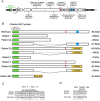MLIP causes recessive myopathy with rhabdomyolysis, myalgia and baseline elevated serum creatine kinase
- PMID: 34581780
- PMCID: PMC8536936
- DOI: 10.1093/brain/awab275
MLIP causes recessive myopathy with rhabdomyolysis, myalgia and baseline elevated serum creatine kinase
Abstract
Striated muscle needs to maintain cellular homeostasis in adaptation to increases in physiological and metabolic demands. Failure to do so can result in rhabdomyolysis. The identification of novel genetic conditions associated with rhabdomyolysis helps to shed light on hitherto unrecognized homeostatic mechanisms. Here we report seven individuals in six families from different ethnic backgrounds with biallelic variants in MLIP, which encodes the muscular lamin A/C-interacting protein, MLIP. Patients presented with a consistent phenotype characterized by mild muscle weakness, exercise-induced muscle pain, variable susceptibility to episodes of rhabdomyolysis, and persistent basal elevated serum creatine kinase levels. The biallelic truncating variants were predicted to result in disruption of the nuclear localizing signal of MLIP. Additionally, reduced overall RNA expression levels of the predominant MLIP isoform were observed in patients' skeletal muscle. Collectively, our data increase the understanding of the genetic landscape of rhabdomyolysis to now include MLIP as a novel disease gene in humans and solidifies MLIP's role in normal and diseased skeletal muscle homeostasis.
Keywords: MLIP; cardiomyopathy; hyperCKemia; myopathy; rhabdomyolysis.
Published by Oxford University Press on behalf of the Guarantors of Brain 2021.
Figures



Comment in
-
Another step towards defining the genetic landscape of rhabdomyolysis.Brain. 2021 Oct 22;144(9):2560-2561. doi: 10.1093/brain/awab308. Brain. 2021. PMID: 34581775 No abstract available.
-
A novel MLIP truncating variant in an 80-year-old patient with late-onset progressive weakness.Brain. 2022 Oct 21;145(10):e99-e102. doi: 10.1093/brain/awac286. Brain. 2022. PMID: 35915960 No abstract available.
References
-
- Stahl K, Rastelli E, Schoser B.. A systematic review on the definition of rhabdomyolysis. J Neurol. 2020;267(4):877–882. - PubMed
-
- Muller-Felber W, Zafiriou D, Scheck R, et al.Marinesco Sjogren syndrome with rhabdomyolysis. A new subtype of the disease. Neuropediatrics. 1998;29(2):97–101. - PubMed
-
- Zafeiriou DI, Ververi A, Tsitlakidou A, Anastasiou A, Vargiami E.. Recurrent episodes of rhabdomyolysis in pontocerebellar hypoplasia type 2. Neuromuscul Disord. 2013;23(2):116–119. - PubMed
Publication types
MeSH terms
Substances
Grants and funding
LinkOut - more resources
Full Text Sources
Medical
Molecular Biology Databases

